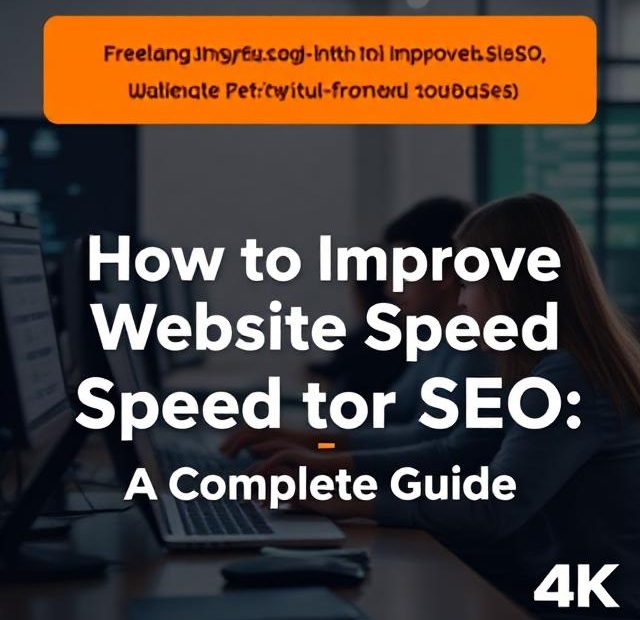When it comes to SEO, most people think of keywords, backlinks, and content. But there’s one crucial ranking factor that often gets ignored: website speed.
Page load time doesn’t just affect how users interact with your website—it also plays a direct role in how search engines rank you. In fact, Google has confirmed that site speed is a ranking factor for both desktop and mobile searches. And when your site is slow, users bounce. Fast-loading websites keep visitors engaged, improve conversion rates, and help search engines crawl more pages efficiently.
So how do you actually improve your website speed for better SEO?
In this article, we’ll break down the why, the what, and most importantly—the how.
Why Website Speed Matters for SEO
Let’s start with the basics.
1. Google Uses Speed as a Ranking Signal
Google cares deeply about user experience. A slow website creates frustration, especially on mobile devices. That’s why site speed is part of Google’s Core Web Vitals—key metrics that affect rankings.
2. Improved User Experience
When your site loads quickly, users stay longer, view more pages, and are more likely to convert. If it’s slow, they leave. It’s that simple.
3. Lower Bounce Rates
A fast website keeps users around. Slow websites increase bounce rates—people hit the back button before your page even finishes loading.
4. Better Crawl Efficiency
Google’s bots have a crawl budget for each site. Faster sites get more pages crawled and indexed, improving your SEO visibility.
Tools to Measure Website Speed
Before you can fix your speed, you need to measure it. Here are some tools to help:
-
Google PageSpeed Insights – Gives scores for mobile and desktop along with detailed suggestions.
-
GTmetrix – Provides in-depth performance reports, including waterfall charts and optimization tips.
-
WebPageTest.org – Offers advanced testing locations and devices, great for global speed checks.
-
Lighthouse (Chrome DevTools) – Built into Chrome’s developer tools, ideal for Core Web Vitals and audits.
Aim for a page load time under 2 seconds, with key metrics like Largest Contentful Paint (LCP) under 2.5s and First Input Delay (FID) under 100ms.
Top Strategies to Improve Website Speed
Let’s dive into practical ways to make your website lightning-fast.
1. Optimize Image Sizes and Formats
Images are often the biggest files on a page. Unoptimized images slow down load times significantly.
How to fix it:
-
Compress images using tools like TinyPNG or ImageOptim.
-
Serve images in next-gen formats like WebP instead of JPEG or PNG.
-
Use responsive images (
srcset) to serve smaller versions to mobile users.
2. Use a Content Delivery Network (CDN)
A CDN stores copies of your site on servers around the world. When users visit, they get data from the nearest server—reducing load times.
Popular CDNs:
-
Cloudflare
-
StackPath
-
Amazon CloudFront
3. Enable Browser Caching
Browser caching stores elements (like stylesheets, logos, etc.) on the user’s device so they don’t need to reload every time.
How to do it:
-
Add caching rules in your
.htaccessfile (for Apache) or server config. -
Use caching plugins (like WP Rocket or W3 Total Cache for WordPress).
4. Minify CSS, JavaScript, and HTML
Minification removes unnecessary spaces, comments, and line breaks to shrink file size.
Tools to use:
-
Online compressors (Minifier.org)
-
Build tools (Gulp, Webpack)
-
WordPress plugins (Autoptimize)
5. Reduce HTTP Requests
Every element on a page (scripts, styles, fonts, etc.) requires a separate request. The more requests, the slower the page.
Fixes:
-
Combine CSS and JS files.
-
Use fewer third-party scripts.
-
Remove unnecessary plugins and fonts.
6. Enable GZIP Compression
GZIP compresses your files before sending them to the browser, drastically reducing transfer size.
Enable it via:
-
.htaccessfile for Apache servers -
cPanel settings
-
Hosting provider options
7. Implement Lazy Loading
Lazy loading defers the loading of images or videos until the user scrolls to them. This reduces initial page load time.
How to do it:
-
Use native lazy loading in HTML (
loading="lazy") -
Install a lazy load plugin for your CMS
8. Choose Fast Hosting
Your hosting provider has a huge impact on site speed. Shared hosting may be cheap, but it’s often slow.
Tips:
-
Consider managed hosting (like Kinsta, WP Engine, or SiteGround).
-
Choose a plan with SSD storage and high performance.
-
Look for hosting with built-in caching and CDN support.
9. Eliminate Render-Blocking Resources
Scripts that delay the rendering of your page can be deferred or loaded asynchronously.
Fix it by:
-
Moving non-essential JS to the footer
-
Adding
asyncordeferattributes to script tags
10. Optimize Your Database
For CMS platforms like WordPress, bloated databases slow down everything.
How to optimize:
-
Clean up old drafts, spam comments, and plugin data.
-
Use plugins like WP-Optimize or Advanced Database Cleaner.
Bonus: Monitor & Maintain
Improving speed is not a one-time task. Make it part of your SEO routine.
-
Audit your site monthly using GTmetrix or PageSpeed Insights.
-
Update plugins, themes, and CMS regularly.
-
Remove unused plugins or themes.
-
Re-optimize images and clear cache often.
Final Thoughts
Improving your website speed is a win-win for both SEO and user experience. A fast site means better rankings, lower bounce rates, higher engagement, and more conversions.
Start by identifying your speed issues using PageSpeed Insights or GTmetrix. Then, tackle them one by one: optimize images, minify code, use a CDN, and choose reliable hosting. Over time, even small improvements in load time can lead to noticeable gains in traffic and rankings.
In today’s competitive digital landscape, speed isn’t optional—it’s essential.
Need help speeding up your site? Reach out to us—we’ll run a free performance audit and help you get faster, smarter, and more visible online.
Also, you can learn more about SEO & Site here.
